Player Cams Necessity: Why They Matter in Modern Sports and Esports
Updated On: August 23, 2025 by Aaron Connolly
Defining Player Cams Necessity

Player cams are now must-haves in gaming and esports. They help audiences connect with players and give analysts new ways to understand competitive performance.
Core Purpose of Player Cams
Player cams do three big things in gaming. They show facial expressions and reactions as the action happens. They let audiences see the people behind the screens. They also give players and coaches footage for reviewing performance.
Streamers rely on player cams to keep their audiences hooked. People want to witness those raw reactions—whether it’s a clutch win or a tough loss. A face on screen just draws folks in.
In competitive esports, player cams capture the tension of pro matches. We watch players’ focus and nerves during high-stakes moments. Broadcast teams use these shots to tell better stories.
Content creators use player cams to add some personality to their videos. A simple gameplay clip gets way more interesting with a live face and some real emotion.
Evolution of Player Cam Use
Player cams started out as cheap webcams hooked up to PCs. Early streamers made do with whatever camera they could get, and the video quality wasn’t great. Setting things up could be a pain.
Professional esports raised the bar. Tournament organizers wanted crisp, clear footage for broadcasts. That pushed the industry to invest in better cameras and production gear.
Tech improvements made player cams easier to use. Cameras now have sharper images and simple plug-and-play setups. Streaming apps come with camera support built right in.
Mobile options have made things even more accessible. In places with fewer resources, players turn their phones into cams. Apps like CamNinja make it easy to stream straight from a mobile device.
Fundamental Benefits for Stakeholders
Different groups get unique perks from player cams:
Players get:
- Closer connections with fans
- A way to review their own reactions and habits
- A professional look for sponsors
Audiences enjoy:
- A more immersive way to watch
- Emotional ties to their favorite players
- A better feel for the pressure and excitement
Teams and coaches use cams for:
- Breaking down performance in detail
- Training and feedback
- Marketing and promo content
Broadcasters benefit from:
- Storytelling that goes beyond the game
- More engaged viewers
- A polished, pro-level production
Player cams do more than just look cool. They’re now key tools for communication, analysis, and entertainment in competitive gaming.
Enhancing Viewer Engagement in Sports
Player cams pull fans closer to the action and make watching feel more real. These cameras catch every grin, grimace, or eye roll that changes the way we experience games.
Immersive Fan Experiences
Player cams give us real-time access to athletes’ reactions. We get to see the tension before a big play or the pure joy after a win.
Modern broadcasts use lots of camera angles for different views. AI steps in to switch angles and keep the best shot on screen.
Interactive features now include:
- Switching between camera angles
- Real-time stats right on the screen
- Instant replays from the player’s point of view
- Social media integration for fan reactions
Drones and AR tech work with these cameras to create experiences you just can’t get from old-school TV.
Fans say they feel more involved when they can actually see the players’ faces. This tech helps make watching from home almost as exciting as being in the stadium.
Emotional Connection Through Facial Expressions
Facial expressions show the human side of athletes. We get to see real frustration, focus, or joy—stuff stats just can’t capture.
Key moments include:
- Pre-game nerves and concentration
- Quick reactions to referee calls
- Team talk during tactical shifts
- Celebrating with teammates after a win
Player cams are great for catching those tiny reactions in tense moments. These little details help fans relate to the pressure athletes face.
Studies show viewers pay more attention when they can see players’ faces during clutch moments. We start to care about the people, not just the game.
The tech really shines during things like penalty shootouts or the final seconds of a close match. Camera operators zoom in on players’ eyes and faces to catch every flicker of emotion.
Key Technology Behind Player Cams
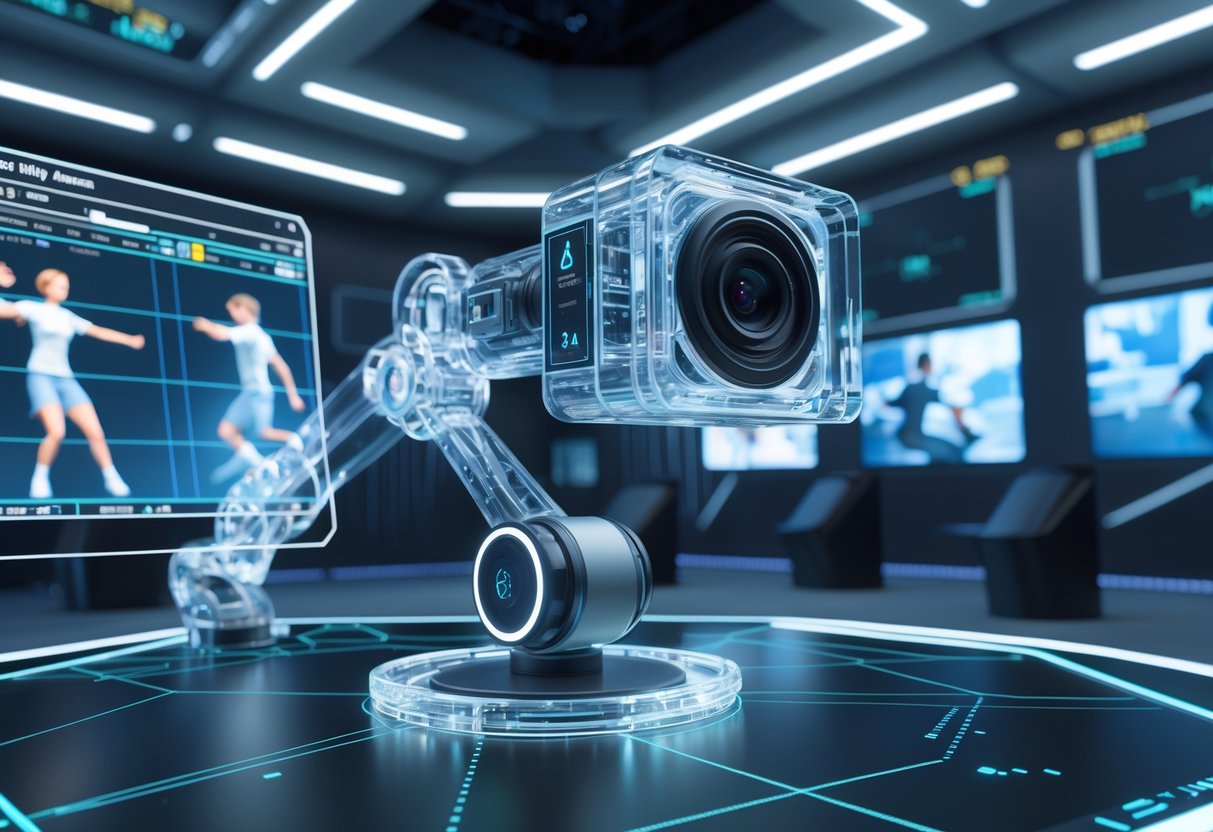
Player cam tech has come a long way from clunky webcams. These days, smart hardware, tracking software, and smooth streaming all work together to catch every moment.
Types of Cameras Used
Three main camera types show up in esports broadcasts now. Standard webcams stick around for budget setups, usually £50-150. They’re easy to use, so a lot of streamers start here.
Marshall CV502 Miniature Cameras take things up a notch. They’re tiny, so you don’t get tangled in cables, but they still give pro-level video.
AI-powered tracking cameras are the new frontier. Tools like PlayerCam use AI to follow players automatically. Top football teams already use this tech for their own analysis.
The real difference is reliability. Webcams sometimes lag or drop frames when things get heated. Pro cameras don’t flinch when it matters most.
| Camera Type | Cost Range | Best For | Key Advantage |
|---|---|---|---|
| Standard Webcam | £50-150 | Beginners | Easy setup |
| Marshall CV502 | £300-500 | Semi-pro | Reliable quality |
| AI Tracking | £1000+ | Professional | Automated operation |
Cutting-Edge Hardware Solutions
Modern player cam gear solves real problems for broadcasters. Cloud tech now lets operators manage whole fleets of cameras from a web app—no more wrestling with hardware racks.
5G connections mean cameras send footage instantly to broadcast centers. No more annoying lag messing up live coverage. The action on screen matches the players’ reactions perfectly.
Miniaturization helps cameras fit into tight spaces without crowding players. The Marshall CV502, for example, is just 55mm but still shoots in full HD.
Heat is an issue too. Pro cameras have built-in cooling, so they keep running through long tournaments. Cheaper setups sometimes overheat and cut out mid-match.
Live Streaming Integration
How well a player cam works with streaming can make or break a broadcast. Direct streaming protocols let cameras connect straight to Twitch or other platforms—no extra gear needed.
Sync tech keeps all the camera feeds lined up with the game. Systems like Hawk-Eye make sure reactions and game moments match up perfectly.
Bandwidth optimization keeps streams smooth, even with lots of cameras running. Pro setups tweak the video quality automatically so the broadcast doesn’t drop out during big moments.
The best systems fit right into existing broadcast workflows. Producers can switch between game action and player faces in a snap. Here’s a tip: test your setup when things are quiet to spot any bandwidth issues before you go live.
Real-time analytics help directors pick the most interesting camera angles. AI can spot when players show big emotions and switch the feed automatically. That means more exciting moments for viewers.
Player Cams in Esports Broadcasts
Player cams bring viewers right into the game, showing live reactions as matches unfold. Big tournaments use these cameras to make broadcasts more exciting, but it takes a lot of tech and bandwidth to get it right.
Role in Professional Esports Events
Modern esports broadcasts rely on player cams for lots of reasons. They help viewers connect with the people behind the keyboards.
Main benefits:
- Catching intense reactions in real time
- Building up player personalities and fan loyalty
- Spicing up highlight reels and social media posts
- Showing the thinking behind in-game decisions
Major tournaments like League of Legends Worlds use multiple camera angles at once.
Player cams help tell stories that go beyond just gameplay. We see the pressure and nerves players deal with in big moments. That human touch makes esports broadcasts stand out from regular game streams.
Different games need different camera styles. Shooters show off reactions to eliminations. Strategy games zoom in on concentration and big decisions.
Challenges with Multi-Player Setups
Running player cams for a bunch of players isn’t easy. Each camera needs its own internet connection and processing power.
Main challenges:
- Bandwidth: Every stream needs a strong, stable connection
- Hardware costs: Every player needs their own camera and encoder
- Sync problems: All the feeds have to line up with the game
- Production headaches: Managing a ton of video sources at once
Team games make things even trickier. A 5v5 match means ten cameras plus the game feed. Organizers have to balance quality and what’s actually doable.
Remote competitions add more problems. Players compete from home with different gear and internet speeds. Cheap webcams often look bad and don’t meet broadcast standards.
Budget issues mean some tournaments skip player cams altogether.
Case Study: Riot Games and VCT Implementation
Riot Games came up with a clever fix for Valorant Champions Tour player cams. They send each player a Raspberry Pi with a camera attached.
How it works:
- Hardware: Raspberry Pi computers running Linux
- Cameras: Dedicated video capture units
- Streaming: Direct feed to Riot’s production team
- Processing: Separate from the gaming PC, so no lag
This setup avoids the usual headaches. Players don’t have to mess with their gaming rigs, and performance stays smooth.
Production teams get the footage in real time and can switch between player reactions instantly.
Other leagues like Overwatch use similar systems. The upfront cost pays off with better broadcast quality and more engaged viewers.
Smaller events usually can’t afford this and stick with simpler setups—or skip cams entirely.
Player Cams in Traditional Sports
Traditional sports have jumped on the player cam trend to give fans a closer look at athletes during games. Coaches now use these camera angles to study player behavior and decisions in the heat of competition.
Football and Basketball Usage
Football and basketball are leading the way with player cam tech. The NFL puts body cams on quarterbacks so we can see the field from their eyes. Basketball uses courtside tracking cams to follow players around the court.
These cameras let us step into the players’ shoes. When a footballer makes a split-second pass, we see exactly what they saw. Basketball cams show how players read the defense.
Key uses:
- Walking through the tunnel before a match
- Bench reactions in tense moments
- Sideline chats with coaches
- Player-view celebrations after a goal
The Premier League runs up to 14 special cameras per match. NBA games have player-tracking systems that follow every move. It’s not just for show—coaches use this footage for instant tactical analysis.
Analysing Player Movements Live
Live player cam analysis is really changing the way coaches make calls during matches. With these systems, you can see heat maps of where players hang out on the pitch. Advanced setups keep tabs on running patterns and even flag fatigue as it happens.
Modern player cams rely on AI-powered tracking technology that spots tactical mistakes in the moment. The system pings coaches if someone drifts out of position. All that data lands right in the coaches’ hands as the match unfolds.
Real-time analysis covers:
- Player positioning relative to teammates
- Sprint speeds and distance covered
- Decision-making under pressure
- Communication patterns between players
The tech even picks up on micro-expressions and small gestures that hint at player confidence. Coaches use these details to make quick substitution calls. Lately, teams have started shifting tactics within minutes based on what player cams show.
Player Cams for Performance Analytics
Player cams take raw match footage and turn it into performance data that actually helps teams and players level up. These systems track things like running distance and tactical positions, so coaches and players get clear, actionable insights.
Integrating Video Data into Analysis
Player cams hook straight into sports analytics software to turn video into useful stats. Each camera tracks player movements during games and training. AI then processes this footage and pulls out key performance indicators.
Coaches get heat maps showing where players spend most of their time. They also see positional data that uncovers tactical habits and decision-making. The system points out specific moments when players made smart or risky choices.
Key data points include:
- Distance covered per match
- Sprint speeds and frequency
- Pass completion rates
- Shot accuracy percentages
- Time spent in different field zones
Teams often use this info to compare players across games. The camera system builds detailed reports, highlighting trends over weeks or months. Coaches catch patterns they might miss during the chaos of live play.
Monitoring Physical and Tactical Metrics
Player cams track physical performance without sticking sensors on athletes. The cameras measure acceleration, deceleration, and top speed throughout a match. This gives coaches a pretty solid read on fitness.
Tactical analysis digs into positioning and team shape. Coaches see how players move in relation to their teammates and opponents. They can check if everyone holds formation during different phases.
Physical metrics tracked:
- Running intensity levels
- Recovery time between sprints
- Movement efficiency scores
Tactical insights provided:
- Formation adherence percentages
- Pressing trigger points
- Defensive line coordination
The camera captures body positioning, so coaches can review footwork during passes or defensive stances. This detail helps target specific skills for improvement.
Teams usually review all this within a day of the match. Fast analysis means coaches can plan training sessions that target recent performance gaps.
Safety and Privacy Considerations
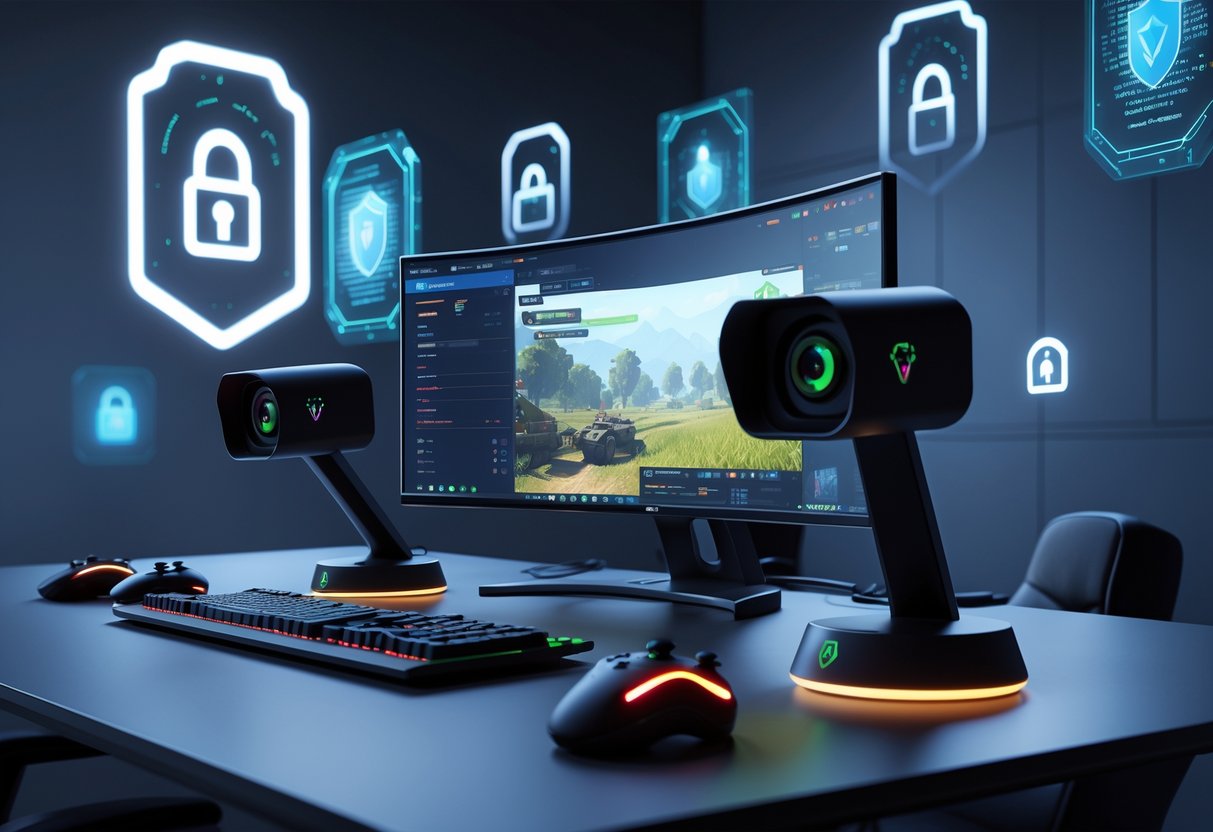
Player cams bring up some tricky issues around protecting streamers’ wellbeing and making sure cameras get used responsibly. Both content creators and tournament organisers have to think carefully when they roll out facial monitoring.
Protecting Player Wellbeing
Player cams put gamers under the spotlight, and that can really mess with mental health. Live facial reactions become content, and players end up getting judged for their looks, expressions, and how they handle pressure.
Harassment risks go way up when faces are visible. Plenty of players report abuse about their appearance, gender, or reactions. Female streamers, in particular, get hit with more objectification and unwanted attention.
Performance anxiety can spike when cameras catch every facial twitch. Some players get self-conscious, worrying about how they look instead of focusing on the game. That kind of distraction really hurts performance.
We suggest these protective measures:
- Position cameras away from private spaces
- Use moderation tools to fight chat harassment
- Offer mental health support for pros
- Schedule breaks from constant camera time
Tournament organisers should let players opt out if they’re not comfortable with facial capture during big matches.
Ensuring Ethical Camera Use
Handling player cam footage takes care to avoid privacy slip-ups. Tournament operators and streaming platforms need to set clear limits on how they use facial monitoring data.
Consent protocols are a must before recording anyone’s face. Players should know exactly how their image will be used, where it’ll be stored, and who gets to see it. That includes whether footage sticks around forever.
Data protection should work like CCTV. Keep facial data secure, limit who can access it, and set clear rules about how long you keep it. Each camera placement needs a real reason.
Commercial usage boundaries should be spelled out. Can tournament highlights use player reaction shots forever? Do players get paid if their expressions go viral?
Technical safeguards to consider:
- Encrypt facial data storage
- Restrict staff access to recordings
- Set up auto-delete schedules
- Have clear usage agreements
Players deserve to know exactly when cameras are recording and when they’re just showing a live feed.
The Role of Coaches and Analysts
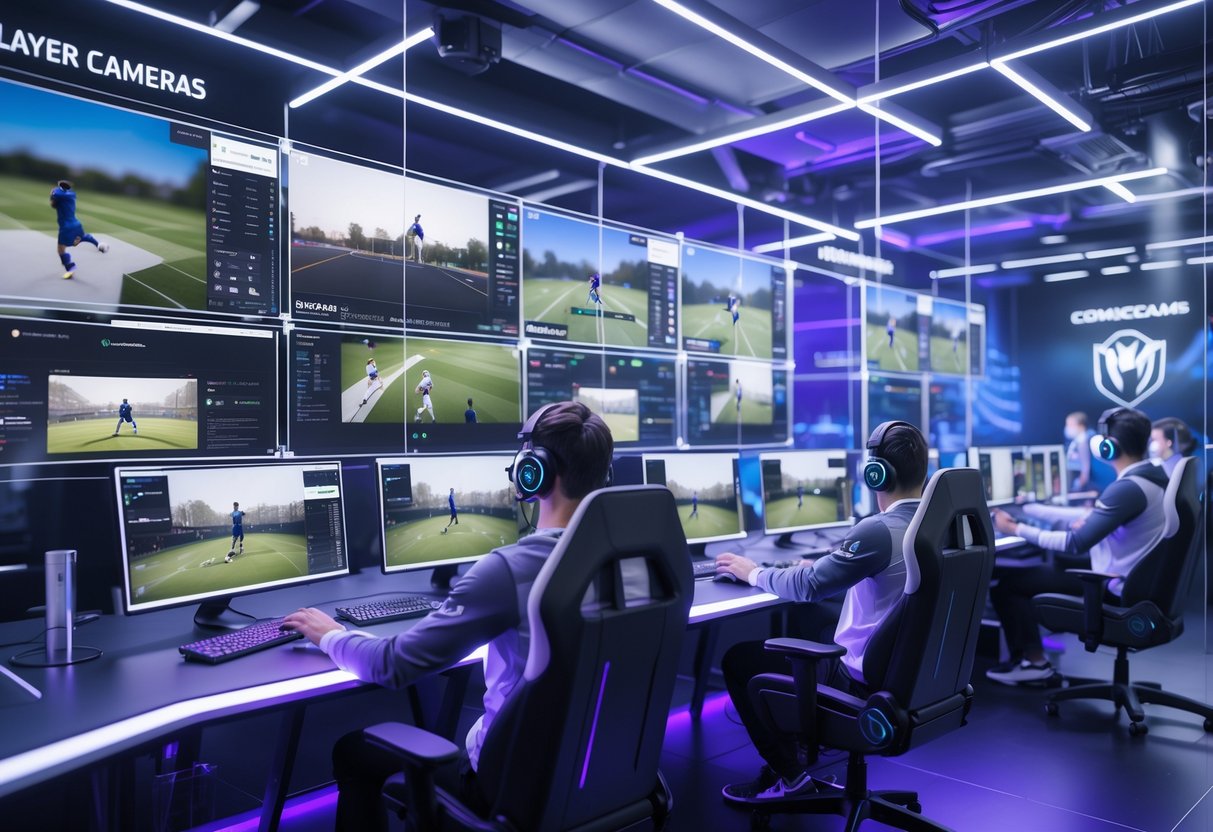
Player cams give coaches a whole new level of access to individual behaviour and decision-making. Modern coaching staff use this footage to build targeted training and give feedback you just can’t get from normal match analysis.
Coaching Strategies Using Player Cam Footage
Player cams have totally changed how coaches develop tactical strategies. Now, you can actually see vision scanning, communication timing, and the subtle positioning choices that regular broadcasts miss.
Key coaching applications include:
- Pre-match preparation: Breaking down opponent tendencies and weak spots
- Formation adjustments: Tracking how players actually move in tactical setups
- Individual development: Building custom training from specific behaviour patterns
Coaches use player cam data to spot pressing triggers and defensive mistakes. For instance, footage might show a midfielder always turning away from pressure in certain areas.
That info lets teams recreate those situations in practice. They can drill right into the problem.
Communication pattern analysis is huge. Player cams catch verbal commands, body language, and leadership moments that drive team chemistry.
A lot of coaching teams now assign analysts to watch several player cam feeds at once during matches. This lets them make tactical tweaks on the fly, based on what each player is actually doing.
Communication and Feedback Enhancement
Player cam footage changes feedback from vague to specific. Instead of saying “you need to be quicker there,” coaches can pull up the exact moment and show what went wrong—or right.
Effective feedback methods with player cams:
- One-on-one review: Break down specific plays together
- Team sessions: Learn from multiple points of view
- Live coaching: Give advice right as footage comes in
This tech helps coaches explain tactics visually. Players see their own positioning in real situations, not just on a whiteboard.
Video compilations get personal. Coaches can build highlight reels that show both successes and areas to fix.
Players improve communication because they watch their own decisions play out. That usually means less pushback on criticism and better tactical awareness.
Coaches use player cams to track progress across matches. They can pull up similar scenarios from different games to show growth.
If you’re just getting started, try analysing player cam footage from set pieces. Positioning and communication are super clear in those moments and easier to address.
Production and Operational Challenges
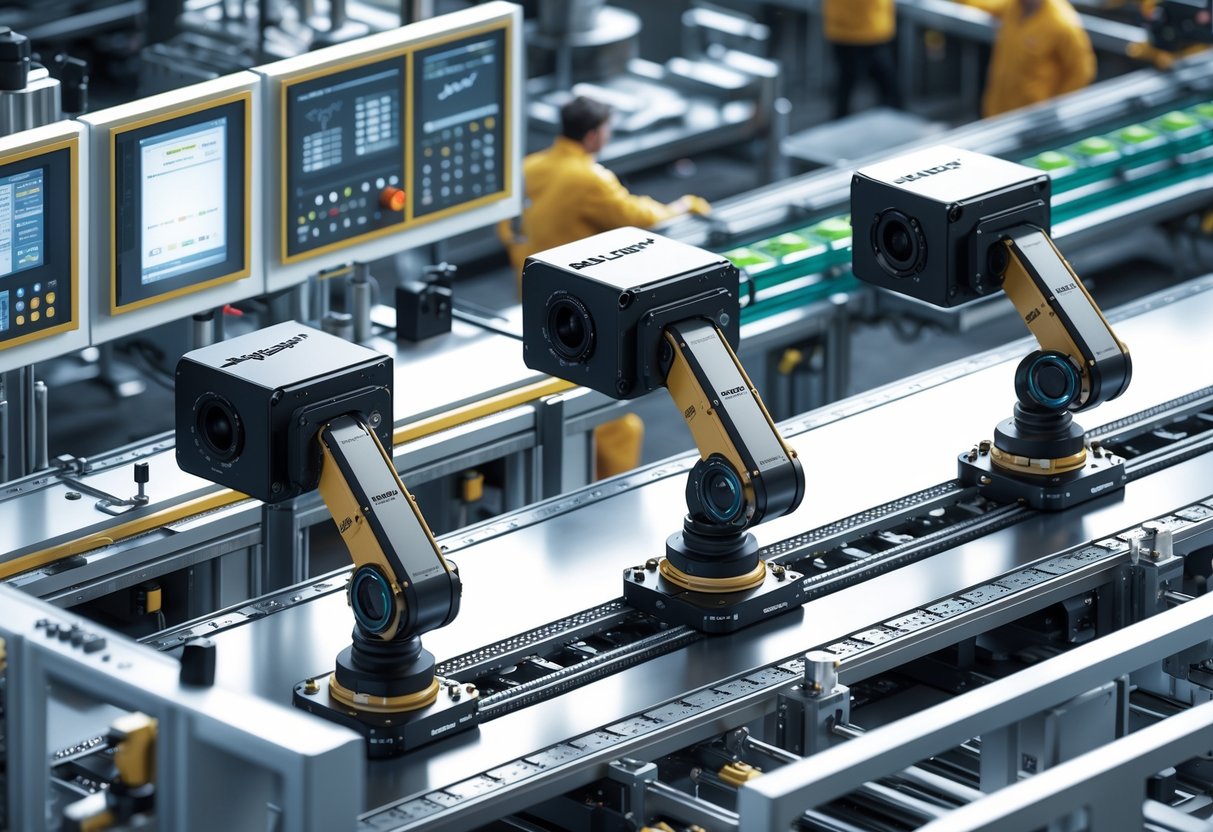
Setting up player cams brings some real technical and logistical headaches. Every new camera feed means more strain on your internet and gear, and big tournaments can turn coordination into a real juggling act.
Bandwidth and Hardware Demands
Running multiple camera feeds chews through your internet bandwidth. Each 1080p stream eats up around 5-10 Mbps upload speed.
A basic three-cam setup needs at least 30 Mbps upload just for video. Most home networks just can’t keep up.
Upload Requirements by Setup Size:
- 2 cameras: 20 Mbps minimum
- 4 cameras: 40 Mbps minimum
- 6+ cameras: 60+ Mbps minimum
Hardware gets expensive fast. Each camera needs a capture card (£100-300 each) and something to mount it on.
Your streaming PC has to handle several video feeds at once. You’ll want a beefy CPU and a solid graphics card, which can push your budget to £1,500 or more.
Heads up: A lot of streamers underestimate what’s needed and end up with dropped frames or crashes during big moments.
Logistical Complexity in Large Events
Big tournaments make camera management a real challenge. You’ll need a camera operator for each feed and a technical director to keep things running smoothly.
Coordinating six cameras means operators have to stay in sync. Everyone needs headsets and clear directions on which player to focus on.
Cable management is a headache with so many cameras. Long HDMI runs (over 15 metres) need boosters or pricey fibre cables.
Quick tip: Test your whole setup at least two days before any big event. That way, you can spot and fix technical issues early.
Syncing up camera timing can be a pain when frame rates don’t match. Professional switchers help, but they’ll add £500-2000 to your costs.
Staffing needs people who know both the game and how broadcasts work. Hiring experienced operators often runs £200-500 per person per event.
Investment and Cost Factors
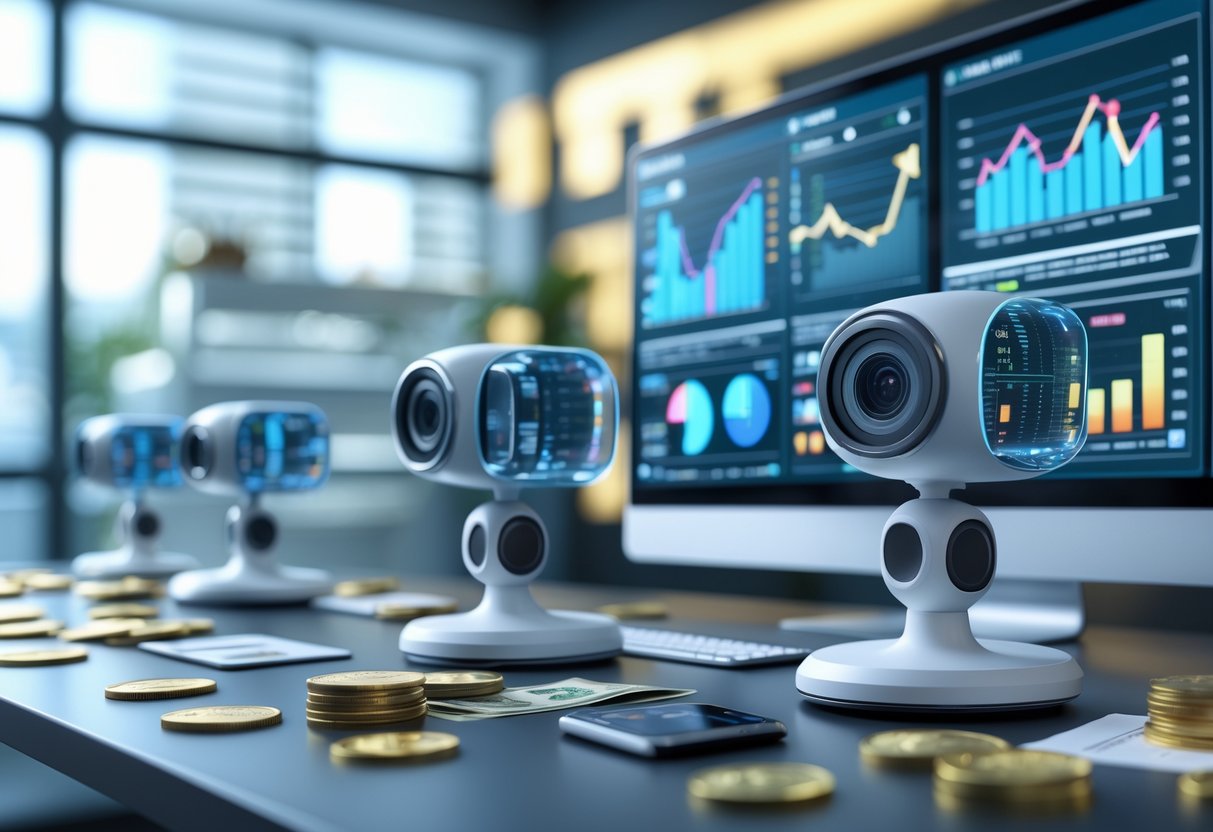
Player cam setups aren’t cheap, and you’ve got to plan for more than just buying the gear. Teams need to look at upfront costs, installation, and ongoing maintenance to make smart choices about their streaming setups.
Budgeting for Player Cam Tech
Equipment Costs
Player cams start at around £50 for basic webcams, but pro models can hit £400 or more. The Logitech C920 (£80-120) is a solid middle ground for most teams.
Other essentials:
- Lighting: £30-150 per setup
- Audio interfaces: £100-300 if you want better mics
- Storage: £50-200 for local drives
- Installation: £200-500 if you hire someone to set it up
Ongoing Operational Expenses
Monthly bills add up. Cloud storage for footage goes for £10-50 per camera. Streaming software licenses run £15-30 a month.
Power isn’t free either—expect £5-15 monthly per camera. And don’t forget replacements; cameras usually need upgrading every few years as standards go up.
Budget Planning Tips
Start small with 2-3 key players instead of covering everyone. That cuts your initial costs by 60-70% and still makes great content.
You might want to look for refurbished pro cameras from broadcast suppliers. They’re often half the price and still deliver great quality.
Return on Investment Analysis
Revenue Generation Potential
Player cams boost several revenue streams. Teams often see 25-40% more engagement when they add multi-angle player footage.
Sponsorship deals get a bump too. Brands pay 30-50% more for teams who offer player reaction videos and behind-the-scenes shots.
Content Monetisation
Player cam footage turns into highlight reels, reaction videos, and training content that can bring in £200-800 a month on YouTube for active teams.
Clips from player cams also help grow social media followings. Teams usually see 15-25% faster audience growth when they post these regularly.
Break-Even Timeline
Most semi-pro teams earn back their investment in 6-12 months through better streaming revenue and more sponsorships.
Pro teams often see returns right away, since better broadcast quality means higher streaming rights fees and more sponsor visibility.
Innovations in Player Cam Technology
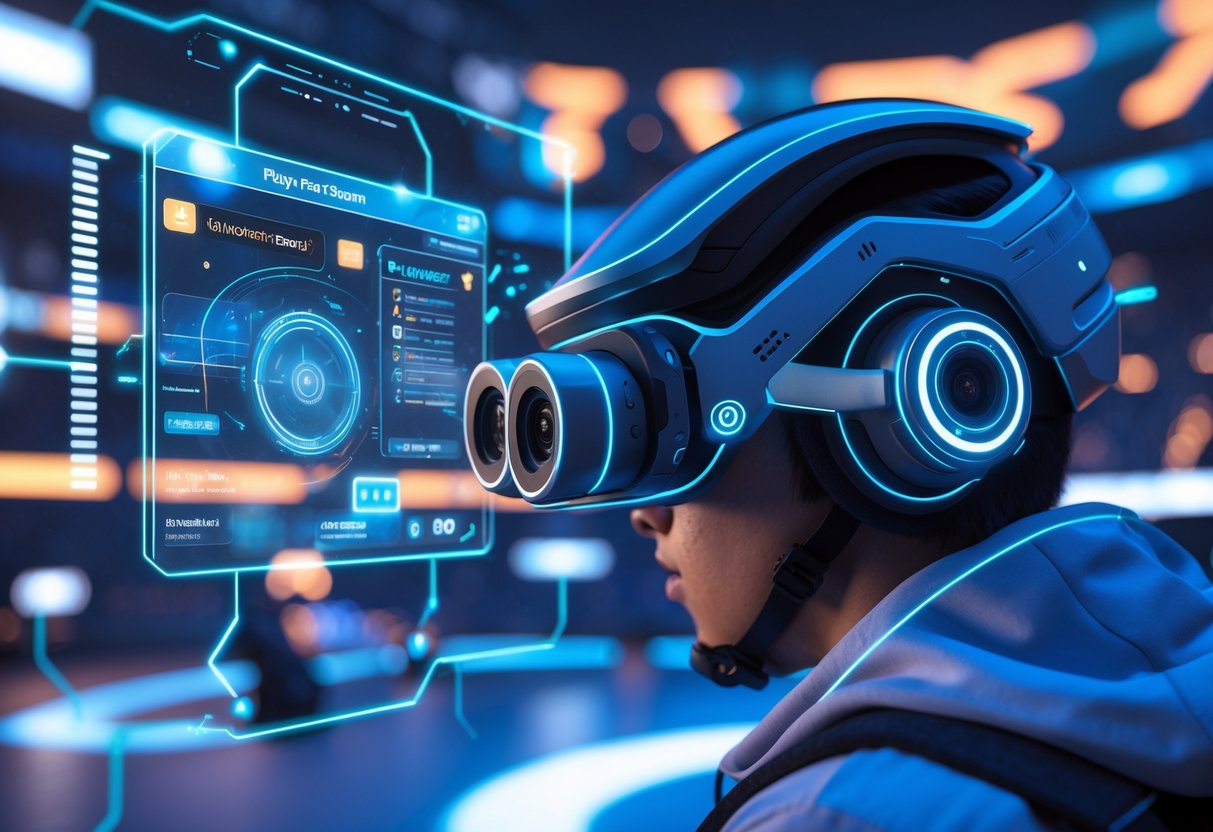
Player cam technology has really changed how we break down and understand football performance. These days, AI-powered systems track every move and offer insights that just weren’t possible a few years back.
AI-Powered Analytics
AI-powered player cams have totally changed how people analyse football. Now, these systems track movements with crazy accuracy. They measure distance run, acceleration bursts, pass completion rates, and shots on target—all automatically.
PlayerCam really stands out here. Over 10 Premier League teams already use it in pilot programs. Teams can drop it right into their existing analytics setups without much hassle.
The tech spits out detailed heat maps so you can see where players spend most of their time. It also draws up positional maps that reveal tactical patterns. Coaches use body positioning analysis to spot small tweaks in technique.
Key metrics include:
- Distance covered per match
- Sprint speeds and acceleration
- Pass accuracy percentages
- Shot placement and power
- Defensive actions per minute
What’s really wild is just how accurate these AI player cams are. They break down footage in real-time, and players don’t even need to wear extra gear. That way, athletes stay focused on the game, and the tech quietly does its thing.
Future Trends in Player Monitoring
Player monitoring technology is quickly becoming cheaper and easier to get. These days, even consumer apps can offer Premier League-level analysis to grassroots football for a fraction of the price.
Machine learning will only make player cams smarter. Soon, systems will predict injury risks by catching changes in running style. They’ll even suggest tactical tweaks during games.
Integration with augmented reality could be next. Imagine coaches seeing player stats pop up over live footage. That would make snap tactical decisions a whole lot easier.
Player cams are probably going to become the norm everywhere, not just at the top. Youth academies will use them to help develop talent. Even amateur teams will get insights that used to be reserved for the pros.
Other sports are jumping on board, too. Cricket, rugby, and more have started using similar systems. Player tracking might soon be as standard as video replay in modern sports.
Community Perspectives and Audience Demands
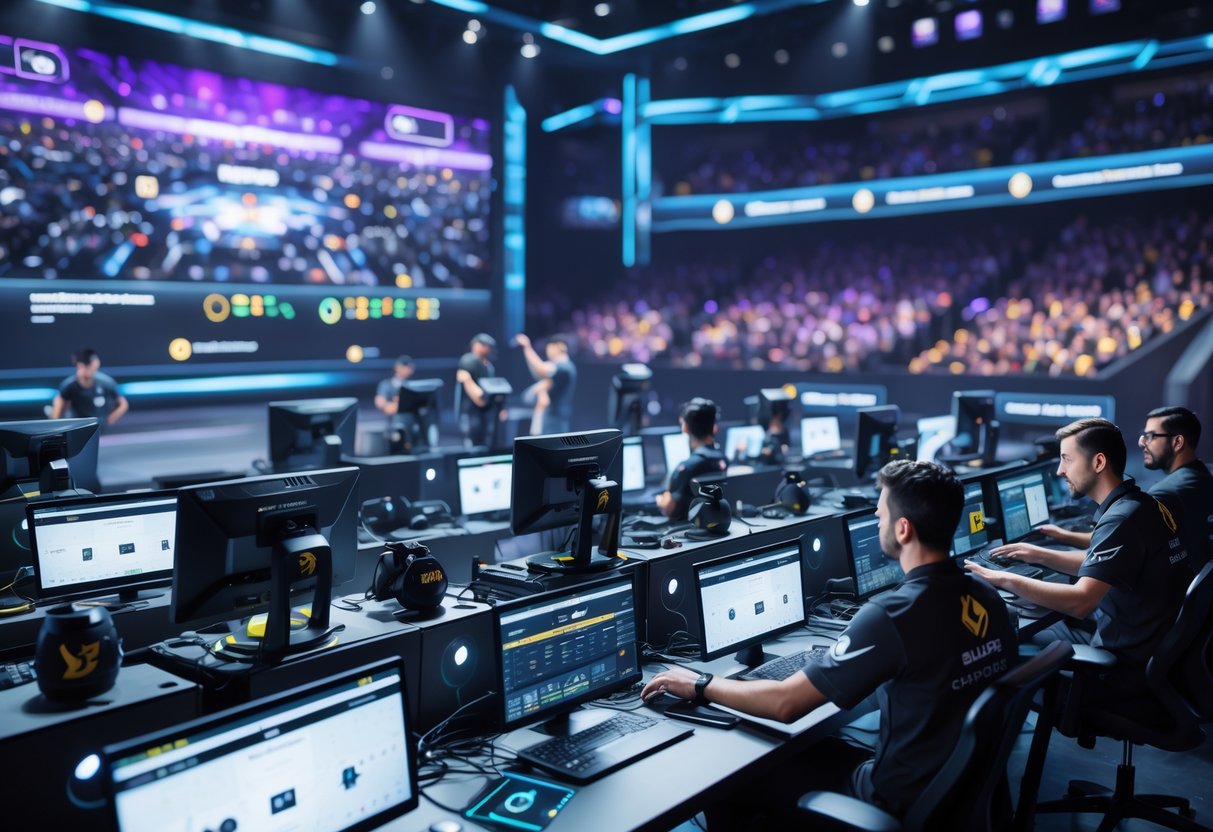
Gaming communities now expect unprecedented access to their favourite players during broadcasts. This shift has forced tournaments to rethink how they cover players and which features really matter to viewers.
Fan Expectations in Modern Broadcasts
Modern esports fans show up with high expectations, thanks to years of sports coverage and nonstop social media. Player cams have become non-negotiable at big tournaments.
Fans want to catch genuine reactions in those clutch moments. They expect close-ups when someone pulls off a brilliant play or takes a tough loss.
Social media spreads these moments instantly. One shocked look or wild celebration turns into shareable content within minutes.
Community feedback keeps showing that tournaments without player cams just feel outdated. A lot of fans say they feel disconnected when they can’t see the players’ reactions.
It’s not just about seeing faces. Viewers want multiple camera angles, picture-in-picture during big plays, and smooth switches between gameplay and player cams.
Tournament organisers who skip player cams usually hear about it on Reddit and Twitter. People often complain that something huge is missing from the broadcast.
Balancing Entertainment and Authenticity
Broadcast teams constantly juggle capturing entertaining moments while respecting player privacy and keeping things fair. Player cams create natural tension between putting on a good show and keeping the competition real.
Some players act differently when they know a camera’s on them. You might see more dramatic reactions, or sometimes, players get more reserved when things get intense.
Gaming expert James Connolly says: “The best player cam coverage feels invisible to competitors but essential to viewers.”
Tournament directors set clear rules for when to focus on individual players. Many avoid close-ups during stressful moments to respect player boundaries.
The best broadcasts strike a balance with smart camera work. They capture real emotions but don’t make players feel like they’re just performing.
Community feedback shapes these calls. Regular surveys and checking social media help broadcast teams figure out when coverage feels authentic versus forced.
Frequently Asked Questions
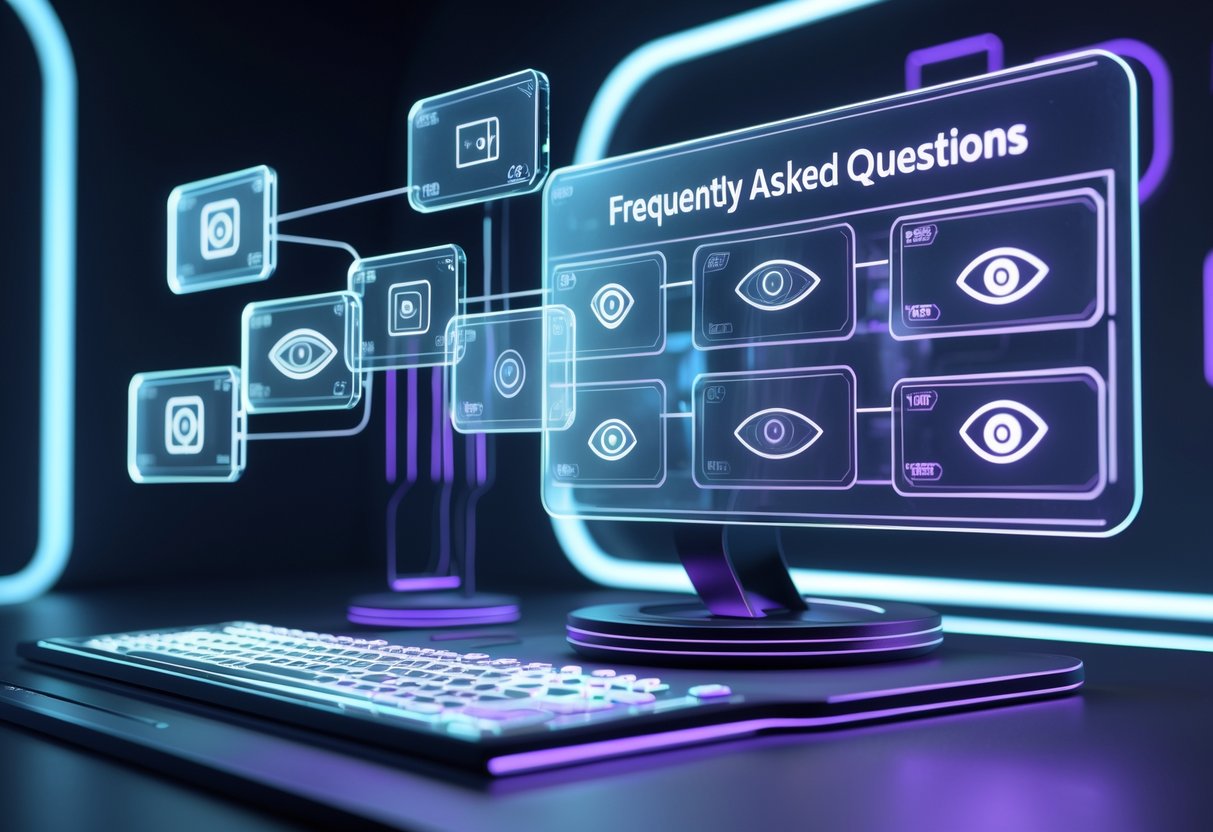
Player cameras have sparked a lot of questions about privacy, fairness, and how teams actually use them in competitive gaming. Teams and fans want to weigh the benefits while keeping an eye on how these systems really work day to day.
What are the benefits of using player cameras during live gaming events?
Player cameras pull viewers right into the action by showing real emotions and reactions. You can catch the focus on a player’s face during tense moments or their excitement after a huge win.
These cams help tell the story of every match. Fans start connecting with players as people, not just random usernames.
Broadcasters use these reactions to build drama and highlight big moments. A frustrated look after a missed shot or a grin after a great play adds something you just can’t get from game footage alone.
How do player cams enhance the viewing experience for fans?
Player cameras make esports broadcasts feel more like traditional sports. Fans can read body language and spot real emotions when the pressure’s on.
A lot of viewers find player cams way more interesting than just watching the map. Parents especially love seeing their kids’ reactions during matches.
The cameras create memorable moments that fans share all over social media. A celebration or a look of disappointment becomes part of the match highlights.
In what ways can player cams improve game strategy and team performance analysis?
Coaches use player cam footage to study body language and stress. They notice when players lose focus or get frustrated.
Team analysts watch footage to spot communication patterns. If a player looks confused or distracted, maybe they need clearer calls from teammates.
Performance reviews get more detailed with visual evidence. Coaches can point out exactly when a player’s posture or mood changed during a tough round.
Are there privacy concerns associated with the use of player cameras in esports?
Player cameras definitely raise privacy questions, especially for younger players. Some athletes just aren’t comfortable being on camera all the time.
Teams have to get consent before filming anyone. Pro contracts now spell out exactly how camera footage gets used.
Tournament organisers usually let players request camera-free periods. Medical breaks or personal moments stay off-camera.
How do teams and organisers ensure that player cams are set up fairly and unobtrusively?
Camera crews follow strict rules to avoid distracting players. Most cameras sit at eye level or just above to get natural expressions.
Tech teams test angles before matches start. Players can ask for tweaks if a camera blocks their view or feels too intrusive.
All teams get equal camera coverage during broadcasts. Organisers rotate focus between players throughout each match.
What technological advancements have been made in the quality and implementation of player cams in recent years?
Modern player cameras now shoot in 4K, which is honestly a big leap from what we had just a few years ago. They handle low-light situations way better, so those old, grainy shots from dim stadium corners? Pretty much gone.
Wireless camera systems have replaced most of the messy cables around gaming setups. Players can move around as much as they want, and nobody has to stress about accidentally yanking something loose.
AI-powered camera switching is another game changer. The system tracks what’s happening in the game and automatically focuses on the right players, all without anyone needing to sit there and press buttons.
